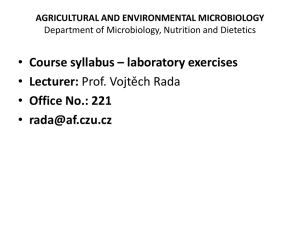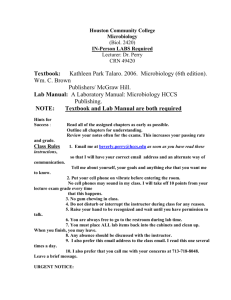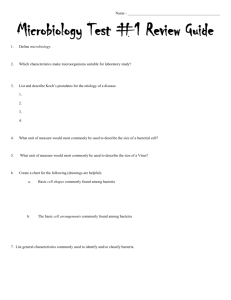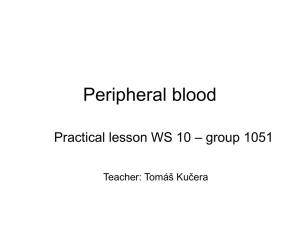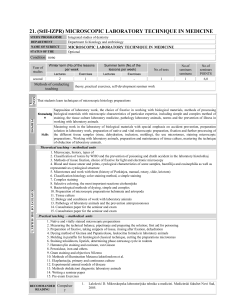Exercise 2. Staining Bacteria for Microscopic Observation
advertisement
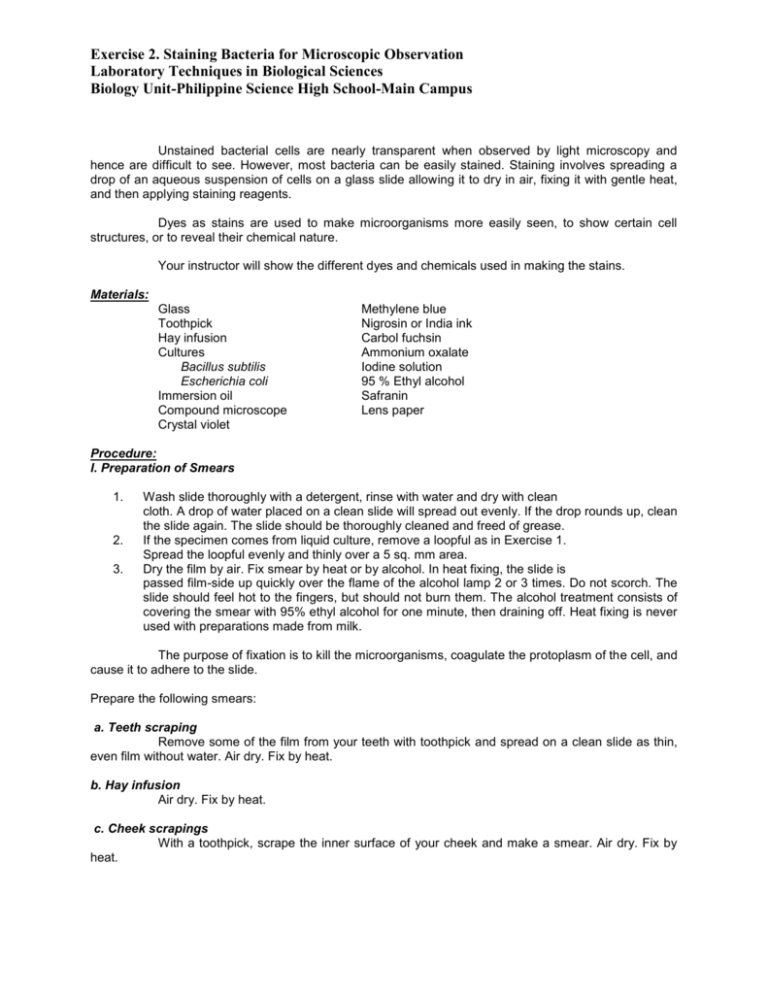
Exercise 2. Staining Bacteria for Microscopic Observation Laboratory Techniques in Biological Sciences Biology Unit-Philippine Science High School-Main Campus Unstained bacterial cells are nearly transparent when observed by light microscopy and hence are difficult to see. However, most bacteria can be easily stained. Staining involves spreading a drop of an aqueous suspension of cells on a glass slide allowing it to dry in air, fixing it with gentle heat, and then applying staining reagents. Dyes as stains are used to make microorganisms more easily seen, to show certain cell structures, or to reveal their chemical nature. Your instructor will show the different dyes and chemicals used in making the stains. Materials: Glass Toothpick Hay infusion Cultures Bacillus subtilis Escherichia coli Immersion oil Compound microscope Crystal violet Methylene blue Nigrosin or India ink Carbol fuchsin Ammonium oxalate Iodine solution 95 % Ethyl alcohol Safranin Lens paper Procedure: I. Preparation of Smears 1. 2. 3. Wash slide thoroughly with a detergent, rinse with water and dry with clean cloth. A drop of water placed on a clean slide will spread out evenly. If the drop rounds up, clean the slide again. The slide should be thoroughly cleaned and freed of grease. If the specimen comes from liquid culture, remove a loopful as in Exercise 1. Spread the loopful evenly and thinly over a 5 sq. mm area. Dry the film by air. Fix smear by heat or by alcohol. In heat fixing, the slide is passed film-side up quickly over the flame of the alcohol lamp 2 or 3 times. Do not scorch. The slide should feel hot to the fingers, but should not burn them. The alcohol treatment consists of covering the smear with 95% ethyl alcohol for one minute, then draining off. Heat fixing is never used with preparations made from milk. The purpose of fixation is to kill the microorganisms, coagulate the protoplasm of the cell, and cause it to adhere to the slide. Prepare the following smears: a. Teeth scraping Remove some of the film from your teeth with toothpick and spread on a clean slide as thin, even film without water. Air dry. Fix by heat. b. Hay infusion Air dry. Fix by heat. c. Cheek scrapings With a toothpick, scrape the inner surface of your cheek and make a smear. Air dry. Fix by heat. Exercise 2. Staining Bacteria for Microscopic Observation Laboratory Techniques in Biological Sciences Biology Unit-Philippine Science High School-Main Campus d. Bacterial Cultures Smear young cultures of B. subtilis and E. coli on opposite ends of the slide. Air dry. Fix by heat. The best bacterial smears are usually made by removing a small amount of surface growth from an agar culture and mixing it with water. It is often possible to use a drop of a culture growing in a liquid medium, but such a smear is not always so satisfactory since certain constituents of the medium may prevent the bacteria from adhering to the slide or may interfere with the staining. The suspension used should always be sufficiently diluted. II. Staining Procedure 1. Simple Staining Teeth scrapings. Stain for 3-5 minutes with methylene blue. Wash with water and air dry. The bacteria will be stained blue. Examine under a 1.8 mm objective (oil immersion objective). Draw the specimen as seen from the microscope. 2. Negative Staining Hay infusion. Pour a uniform layer of Nigrosin or India ink over the smear. Drain off excess dye and air dry. Do not wash the slide. Unstained cells appear in an even dark gray background. Examine under a 1.8 mm objective (oil immersion objective). Draw the specimen as seen from the microscope. 3. Differential Staining Cheek scraping. Stain with methylene blue for 5 seconds. Wash with water. Counterstain with carbol fuchsin for 3 seconds. Wash with water and air dry. The epithelial cells appear pink and Diplococcus salivarius appear dark blue. Examine under a 1.8 mm objective (oil immersion objective). Draw the specimen as seen from the microscope. 4. Gram Staining B.subtilis and E. coli. Stain with ammonium oxalate crystal violet for 1 minute. Wash thoroughly but gently in tap water. Cover smears with iodine solution for 1 minute. Wash in tap water and shake off excess moisture. Decolorize with 95% ethyl alcohol for 15-20 seconds. Wash with water. Counterstain with safranin solution for 30 seconds. Wash with tap water and blot dry. The Gram-positive organisms appear blue or deep violet; the Gram-negative, red or pink. Examine under a 1.8 mm objective (oil immersion objective). Draw the specimen as seen from the microscope. Exercise 2. Staining Bacteria for Microscopic Observation Laboratory Techniques in Biological Sciences Biology Unit-Philippine Science High School-Main Campus This lab. exercise was partially adapted from: FERNANDEZ, W.L., I.F. DALMACIO, A.K. RAYMUNDO, AND A.F. ZAMORA. 1995. Laboratory Manual: General Microbiology. 2nd ed. University of the Philippines Los Baños (UPLB). Microbiology Laboratory, IBS, CAS, UPLB. 115 pp. LIST OF REFERENCES (or any microbiology book or microbiology manual) BLACK, J.PG. 1993. Microbiology Principles and Applications. 2 nd Ed. Englewood Cliffs, N.J. Prentice Hall. 777 p. COLLINS, C.H., P.M. LYNE and J.M. GRANCE. Microbiological Methods. 6th ed. London: Butterworths. 409 p. KETCHUM, P.A. 1988. microbiology: Concepts and Applications. New York: John Wiley, 795 p. PELZAR, M.J., E.C.S. CHAN and N. R. Krieg. 1993. Microbiology Concept and Applications. 1st ed. N.Y.: McGraw Hill, Inc. 896 p. QUESTIONS TO ANSWER 1. Explain the principle behind Gram staining. 2. Why are the steps in Gram staining so carefully standardized? 3. What color in gram positive and gram negative bacteria would the cells have when viewed microscopically after the following treatments: a. b. c. d. e. Ammonium oxalate Crystal violet Ethyl alcohol Safranin Iodine 4. Why are bacterial spores not considered to be true reproductive bodies like the spores of yeasts and molds? 5. Of what importance are spore-forming bacteria in the food industry? 6. Of what practical significance are capsule-forming bacteria in industry and in medicine? Exercise 2. Staining Bacteria for Microscopic Observation Laboratory Techniques in Biological Sciences Biology Unit-Philippine Science High School-Main Campus Name: _________________________ Date: __________________________ Group Number: _________ Score: _________________ Teacher’s Notes: II. 1. Figure ___. ____________________ Observations: _______________________________ _______________________________ _______________________________ _______________________________ _______________________________ Magnification: __________________ Countersignature: ________________ II. 2. Figure ___. ____________________ Observations: _______________________________ _______________________________ _______________________________ _______________________________ _______________________________ Magnification: __________________ Countersignature: ________________ Exercise 2. Staining Bacteria for Microscopic Observation Laboratory Techniques in Biological Sciences Biology Unit-Philippine Science High School-Main Campus II.3. II.4.1. Figure ___. ____________________ Observations: _______________________________ _______________________________ _______________________________ _______________________________ _______________________________ Magnification: __________________ Countersignature: ________________ II.4.2 Figure ___. ____________________ Observations: _______________________________ _______________________________ _______________________________ _______________________________ _______________________________ Magnification: __________________ Countersignature: ________________ Figure ___. ____________________ Observations: _______________________________ _______________________________ _______________________________ _______________________________ _______________________________ Magnification: __________________ Countersignature: ________________ II. 4.3. Figure ___. ____________________ Observations: _______________________________ _______________________________ _______________________________ _______________________________ _______________________________ Magnification: __________________ Countersignature: ________________ Exercise 2. Staining Bacteria for Microscopic Observation Laboratory Techniques in Biological Sciences Biology Unit-Philippine Science High School-Main Campus II. 4.4. Figure ___. ____________________ Observations: _______________________________ _______________________________ _______________________________ _______________________________ _______________________________ Magnification: __________________ Countersignature: ________________ II. 4.5. Figure ___. ____________________ Observations: _______________________________ _______________________________ _______________________________ _______________________________ _______________________________ Magnification: __________________ Countersignature: ________________

